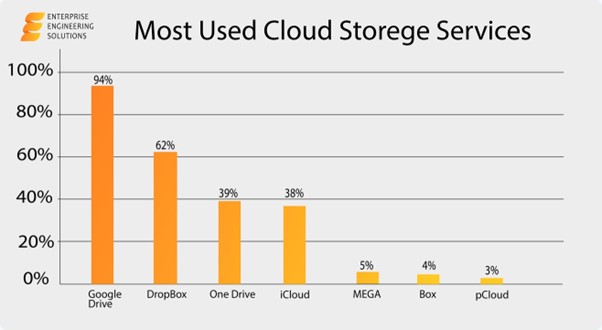The last three years have been revolutionary for cloud technologies. From changing work and consumption habits to the shift in how we approach decentralised technology, the time is now for the cloud.

In fact, in 2020, the combined end-user spending on cloud services totalled $270 billion. In 2021, this increased by 23.1 per cent to a staggering $332.3 billion. By 2022, projections indicate that this figure will rise to $397.5 billion.
But what do clouds have to do with marketing anyway? Aren't we told to keep our heads out of them? Don't they spoil a lovely, sunny day? Wait, not that kind of cloud?!
But why, oh why, is cloud marketing having its time in the proverbial sun?
Well, it could all be down to digital marketing being a pretty tricky game. Many digital marketers have a bunch of spinning plates, so organisation is a necessity. Cloud marketing, then, is an efficient way to boost productivity, processes, and security.
Cloud computing, and the tools and applications integrated into it, are accessible from anywhere, meaning that data storage and distribution can be conducted with ease. It also reduces the burden on IT. Basically, it's all about enhancing operations.
Cloud computing is a huge deal at the moment. In fact, we're seeing moves such as Broadcom's $61B acquisition of cloud computing firm VMware, a decision made to boost Broadcom's software business, and one of the biggest tech acquisitions ever.
Not enough evidence for you? Well, number one: you're greedy but ambitious. I like that. Number two: hold onto your horses, because we've got a load more cloud computing statistics heading your way. Strap in.
The Current State Of The Cloud Computing Landscape
- 92% of organisations already have a multi-cloud strategy
- According to European organizations, migrating more workloads to the cloud is the most important cloud initiative (70%). This is followed by optimising current cloud use to cut down on costs (59%) and advancing a cloud-first strategy (50%).
- Over 30 Cloud-Based Services are Part of Average Employees’ Daily Routines
- Cloud infrastructure services generate $178 billion per year in revenue
- Amazon S3 owns 44% of the enterprise cloud storage market
- Dropbox Owns 47.3% of the US Consumer Market
- According to GoodFirms research, Usage & Trends of Personal Cloud Storage is as follows:
- Google Drive is the world’s most widely utilised cloud storage service, with an astounding 94.44%
- Next is Dropbox, the finest collaborative cloud storage, with an amazing 66.2%
- OneDrive (39.35%), and iCloud (38.89%).
- MEGA (5.09%), box (4.17%) and pCloud (1.39%) are also frequently utilised.

- 100 ZB of data will be stored in the cloud by 2025
- 50% of the world’s corporate data is stored in the cloud
- Cloud data centres account for 3% of the world’s energy consumption
- Cloud infrastructure services generate $178 billion per year in revenue
- 90% of large enterprises have adopted a multi-cloud infrastructure
- Enterprises use an average of 2.6 public and 2.7 private clouds
Cloud Adoption Statistics
- 80% of companies say operation improvements within the first few months of adopting the tech.
- Medium-sized businesses find it 40% more cost-effective to employ third-party cloud platforms than to maintain an in-house system.
- Platform-as-a-Service (PaaS) grew in adoption to 56% by 2020.
- By 2022, the adoption of cloud technologies by other countries will fall behind the US by several years.
- Cloud adoption statistics reveal that in 2020 a staggering 83% of the companies' workload was stored on the cloud.
- The growing adoption of cloud services will increase the need for additional IT infrastructure.
- The positive impact of cloud technology is almost instantaneous. 80% of companies report operation improvements within the first few months of adopting the tech.
- A major reason for the hypergrowth of the public cloud is its affordability. Small and medium businesses find it 40% more cost-effective to employ third-party cloud platforms than maintaining an in-house system.
The Cloud and Data Privacy
- Organisations seem to place a high degree of trust in cloud computing on the whole, with 48% of businesses choosing to store their classified and most important data on the cloud; this includes both encrypted and “regular” data
- 94% of businesses say significant online security improvements after moving their data to the cloud.
- Cloud technology is so reliable when it comes to safety that 94% of businesses report significant improvements in online security after moving their data to the cloud.
- 75% of businesses are highly concerned with cloud safety problems. Of those who were highly worried, 33% were very concerned about 42%, while just 25% were not concerned about somewhat.
- According to checkpoint cybersecurity experts say that the main difficulties in terms of cloud security are cloud misconfiguration (68%), illegal access (58%); unsecured API (52%), accounts, services, or traffic hijacking (50%), and the share of external data (43%).
- More than half (52%) of companies choose cloud solutions with their native safety features.
Cloud Growth Statistics
- Demand enterprise storage solutions, ethernet switches, and servers show a 10.9% growth rate
- The public cloud market generated as high as $130 Billion
- The manufacturing industry spend the most on Cloud Computing solutions in 2021
- Cloud computing applications have tripled since 2013
- Businesses with useful overall mission-critical company information are around 7%
- Public cloud market revenue is expected to grow to $331 billion
- Cloud computing is considered as the number 1 in-demand hard skill
- Email services are the predominant cloud computing uses in the EU with 66%

Enterprise Cloud Computing
- Enterprises face many challenges, but three of the most prevalent issues include security (83%), managing cloud computing spending (82%) and governance (79%).
- Business owners lament the fact that around 30% of their cloud budget goes to waste.
- 90% of large enterprises have adopted a multi-cloud infrastructure
- Most organisations don’t use multi-cloud management tools
- 82% of enterprises use a hybrid cloud model
- Enterprises use an average of 2.6 public and 2.7 private clouds
- 53% of IT decision-makers say multi-cloud helps them achieve their business goals
- The average business runs 38% of workloads in public and 41% in private cloud
- Professional services account for 12.2% of the global cloud spending
- The most prominent industries looking to spend the most on cloud computing are manufacturing ($20 billion), professional services ($18 billion), and banking ($16 billion)
The Cloud in The Future: Forecasts and Predictions
- 100 zettabytes of data will be stored in the cloud by 2025
- Public cloud services spending could reach $480 billion in 2022
- Global cloud infrastructure spending is projected to reach $118 billion by 2025
- The cloud gaming market could be worth over $6 billion by 2024
- 36% of commercial real estate executives plan on investing in cloud computing
